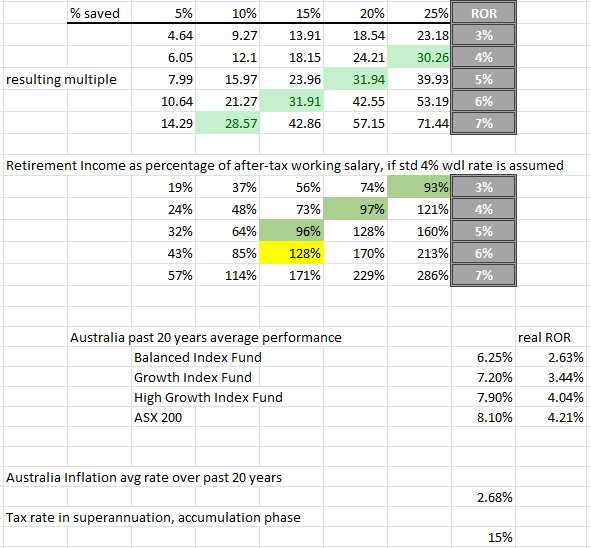For anyone in the early stages of retirement savings, it might be of interest to see a rough projection of how savings rate (how much of your after tax salary you save towards retirement) and expected average real, after tax returns would affect your 'likely' amount available to fund retirement after 45 years of working. Of course sequencing risk can alter the final amount even for identical savings rates and average return, but this simple projection will at least provide a 'ball park' indication of where you could end up.
I expressed the final result as a multiple of average annual after-tax salary, and for simplicity I held the salary constant throughout the 45 years period (assuming someone starts full-time work at age 20 and retuires at age 65).
I used real (after deducting inflation adjustment), after tax rates of return. While we don't know how tax rates and inflation will vary over a 45 year period, this will provide a rough guide to the impact of average rate of real return over the investment timeframe. For illustrative purposes I listed some such returns over the past 20 year period after allowing 15% for tax (eg. holding the retirement savings within superannuation in accumulation phase) and 2.68% for inflation (the average over the past 20 years in Australia).
The results indicate that if you saved 10% of your salary and your investment earned an after tax real return of 7% your retirement savings after 45 years might end up at about 28.57x your after tax salary. Using the 'rule of thumb' 4% initial retirement savings withdrawal rate this would provide a retirement income of 114% of your after tax salary.
However, a 7% real after tax rate of return seems very unlikely, so a more realistic expectation if invested in a 'high growth' portfolio (say 80%+ in the stock market) might be something like 4%. If you invested 15% of your after tax salary (probably close to the value 12% SGL contribution if their average income tax rate is above 15%). this average rate of return would result in a retirement savings final multiple of 18.15x after tax salary. Which would provide a retirement income stream of 75% of your average after tax salary. This is probably quite sufficient for many people, as it is more than the full Age Pension which is currently worth 29.83% of AWOTE for a single pensioner. Hence the intention of successive Australian governments to eventually have most workers end up as 'self funded' retirees, rather than relying on the Age Pension.
If you want your retirement income (assuming a 4% initial withdrawal rate) to be roughly 100% of your after tax salary, and expect to achieve an average real after tax rate of return around 4% on your retirement portfolio, then you would have to save closer to 20% of your after tax salary.
If you were a less risk tolerant investor and invested in a balanced asset allocation within your superannuation fund, then the real after tax ROR would be closer to 3% and you would need to save around 25% of your after tax salary for retirement (eg. add to SGL contributions with salary sacrifice of deductible or undeducted contributions).
It is impossible to make accurate 'projections', but at least these rough figures should indicate the 'ball park' of retirement savings rate required to achieve a particular retirement income stream, expressed as a percentage of your average after tax salary.
Subscribe to Enough Wealth. Copyright 2006-2023

No comments:
Post a Comment